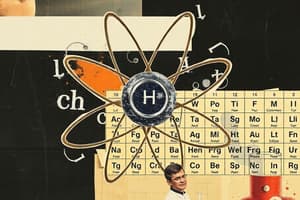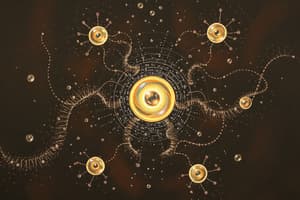Podcast
Questions and Answers
A metalloid has the physical appearance and properties of a ______ but behaves chemically like a non-metal.
A metalloid has the physical appearance and properties of a ______ but behaves chemically like a non-metal.
metal
The ______ was discovered by J.J. Thomson.
The ______ was discovered by J.J. Thomson.
electron
A proton is located in the ______ of an atom.
A proton is located in the ______ of an atom.
nucleus
The atomic number (Z) represents the number of ______ in a nucleus.
The atomic number (Z) represents the number of ______ in a nucleus.
Signup and view all the answers
The mass of an atom is measured using mass ______.
The mass of an atom is measured using mass ______.
Signup and view all the answers
Isotopes have the same atomic number but different atomic ______.
Isotopes have the same atomic number but different atomic ______.
Signup and view all the answers
Natural abundance refers to the percentage of an isotope present in a sample of ______.
Natural abundance refers to the percentage of an isotope present in a sample of ______.
Signup and view all the answers
Uranium-235 has a natural abundance of ______ %.
Uranium-235 has a natural abundance of ______ %.
Signup and view all the answers
The mass of an electron is approximately ______ x 10–28 g.
The mass of an electron is approximately ______ x 10–28 g.
Signup and view all the answers
Hydrogen-1 has a mass of 1.67 x 10–______ g.
Hydrogen-1 has a mass of 1.67 x 10–______ g.
Signup and view all the answers
An atom is the smallest particle of an element that has the chemical properties of that ______.
An atom is the smallest particle of an element that has the chemical properties of that ______.
Signup and view all the answers
Elements with symbols are often derived from ______ and German names.
Elements with symbols are often derived from ______ and German names.
Signup and view all the answers
The elements Sodium and Potassium belong to Group ______ on the periodic table.
The elements Sodium and Potassium belong to Group ______ on the periodic table.
Signup and view all the answers
The vertical columns of the periodic table are referred to as ______.
The vertical columns of the periodic table are referred to as ______.
Signup and view all the answers
Alkaline earth metals are found in Group ______.
Alkaline earth metals are found in Group ______.
Signup and view all the answers
The noble gases occupy Group ______ on the periodic table.
The noble gases occupy Group ______ on the periodic table.
Signup and view all the answers
Transition metals are found between Groups ______ and ______.
Transition metals are found between Groups ______ and ______.
Signup and view all the answers
The substance that does not conduct electricity and is neither malleable nor ductile is classified as a ______.
The substance that does not conduct electricity and is neither malleable nor ductile is classified as a ______.
Signup and view all the answers
Metals are known to be good conductors of ______.
Metals are known to be good conductors of ______.
Signup and view all the answers
The lanthanides and actinides form the ______-block of the periodic table.
The lanthanides and actinides form the ______-block of the periodic table.
Signup and view all the answers
The relative atomic mass of carbon-12 is defined as ______ u.
The relative atomic mass of carbon-12 is defined as ______ u.
Signup and view all the answers
One mole of atoms is equal to ______ atoms.
One mole of atoms is equal to ______ atoms.
Signup and view all the answers
The molar mass of an element is numerically identical to its ______ in atomic mass units (amu).
The molar mass of an element is numerically identical to its ______ in atomic mass units (amu).
Signup and view all the answers
For carbon, the calculation to find the average atomic mass involves the isotopes carbon-12 and ______.
For carbon, the calculation to find the average atomic mass involves the isotopes carbon-12 and ______.
Signup and view all the answers
1 atomic mass unit (1 u) is defined as 1/12 the mass of an atom of ______-12.
1 atomic mass unit (1 u) is defined as 1/12 the mass of an atom of ______-12.
Signup and view all the answers
The number of neutrons in carbon-12 is ______.
The number of neutrons in carbon-12 is ______.
Signup and view all the answers
Mass of a single carbon-12 atom is ______ x 10^-23 g.
Mass of a single carbon-12 atom is ______ x 10^-23 g.
Signup and view all the answers
The formula for calculating the number of moles is mass of sample divided by mass of one mole of the ______.
The formula for calculating the number of moles is mass of sample divided by mass of one mole of the ______.
Signup and view all the answers
The isotope with one neutron is called ______.
The isotope with one neutron is called ______.
Signup and view all the answers
The isotope Tritium has a mass number of ______.
The isotope Tritium has a mass number of ______.
Signup and view all the answers
The mass number denoted by A represents the total number of protons and ______ in the nucleus of an atom.
The mass number denoted by A represents the total number of protons and ______ in the nucleus of an atom.
Signup and view all the answers
Hydrogen, Deuterium, and Tritium are all isotopes of the element ______.
Hydrogen, Deuterium, and Tritium are all isotopes of the element ______.
Signup and view all the answers
Carbon-12 and Carbon-13 are isotopes of carbon with mass numbers of ______ and 13, respectively.
Carbon-12 and Carbon-13 are isotopes of carbon with mass numbers of ______ and 13, respectively.
Signup and view all the answers
The average atomic mass takes into account the natural ______ of the isotopes of an element.
The average atomic mass takes into account the natural ______ of the isotopes of an element.
Signup and view all the answers
The average atomic mass is expressed in atomic mass ______ (amu).
The average atomic mass is expressed in atomic mass ______ (amu).
Signup and view all the answers
To calculate the average atomic mass, each exact mass is multiplied by its percent abundance expressed as a ______.
To calculate the average atomic mass, each exact mass is multiplied by its percent abundance expressed as a ______.
Signup and view all the answers
Isotope names are written by stating the element's name followed by its mass ______.
Isotope names are written by stating the element's name followed by its mass ______.
Signup and view all the answers
Tritium is noted as ______ due to its radioactive nature.
Tritium is noted as ______ due to its radioactive nature.
Signup and view all the answers
The relative atomic mass of an element can be calculated only if both the exact atomic ______ and its percent abundance are known.
The relative atomic mass of an element can be calculated only if both the exact atomic ______ and its percent abundance are known.
Signup and view all the answers
Carbon-12 has a percent abundance of ______ 98.90.
Carbon-12 has a percent abundance of ______ 98.90.
Signup and view all the answers
Study Notes
Atomic Structure
- The smallest unit of an element is called an atom.
- An element is a substance composed of atoms that possess identical chemical properties.
- Some element symbols are derived from Latin or German names, such as Sb for antimony (stibium), Cu for copper (cuprum), and Au for gold (aurum).
Periodic Table
- The periodic table is a visual representation of elements arranged by atomic number and chemical properties.
- Groups are vertical columns representing elements with similar chemical properties, while periods are horizontal rows.
- Elements within the same group are called congeners.
- Alkali metals (Group I) include Na, Li, K, Rb, and Cs.
- Alkaline earth metals (Group II) include Be, Ca, Mg, Sr, and Ba.
- Halogens (Group VII) include F, Cl, Br, and I.
- Noble gases (Group VIII) include Kr, He, Ne, Xe, and Rn.
- Transition metals are located between Groups II and III.
- The periodic table can be divided into blocks: s-block (Groups I and II), p-block (Groups III-VIII), d-block (transition metals), and f-block (lanthanides and actinides).
Minerals in Multivitamins and Baby Formula
- Common minerals found in multivitamin preparations and baby formula include Ca, P, Mg, Fe, Zn, Mn, Cu, I, Se, Na, K, and Cl.
Metals, Non-metals, and Metalloids
- A metal is a substance characterized by its electrical conductivity, metallic luster, malleability, and ductility.
- A non-metal lacks electrical conductivity, malleability, and ductility.
- Metalloids exhibit physical characteristics resembling metals but behave chemically like non-metals. Examples include Si, Ge, As, and Te.
Atom
- The atom consists of three subatomic particles: electrons, protons, and neutrons.
- Electrons were discovered by J.J. Thomson.
- Electrons carry a negative charge, denoted as e–.
- The charge of an electron is -1.6 x 10–19 C, and its mass is 9.1 x 10–28 g.
- Protons were discovered by James Chadwick.
- Protons carry a positive charge and are denoted as p.
- They are 1836 times heavier than electrons and reside in the nucleus.
Atomic Number
- The atomic number (Z) represents the number of protons in the nucleus of an atom.
- It is generally shown above the chemical symbol of an element.
- Since atoms are electrically neutral, the number of protons equals the number of electrons.
- For example, Au has Z = 79, meaning it contains 79 protons and 79 electrons.
- Z can be written as a subscript to the left of the chemical symbol.
- The mass number (A) is calculated as A = Z + N, where N is the number of neutrons.
Mass of an Atom / Isotope
- The mass of an atom is measured using mass spectroscopy (MS).
- For instance, 1 H has a mass of 1.67 x 10–24 g, and 12C has a mass of 1.99 x 10–23 g.
- Isotopes are atoms of the same element with the same atomic number (Z) but different atomic masses (A).
- They have an equal number of protons but differ in the number of neutrons.
- The term "isotope" originates from the Greek word "equal place," indicating that despite their varying masses, they belong to the same element in the periodic table.
- Examples include hydrogen isotopes: 1H (protium), 2H (deuterium), and 3H (tritium).
Isotopic Abundance
- Isotopic abundance refers to the percentage of an isotope present in a sample of the element, expressed in terms of the number of atoms.
- Natural abundance is the abundance in a sample of naturally occurring material.
- For example, Neon-20 has a natural abundance of 91%, while Uranium-235 has a natural abundance of 0.7%.
Mass Number
- The mass number (A) represents the total number of protons and neutrons in the nucleus of an atom.
- If the mass number (A) and atomic number (Z) are known, the number of neutrons can be determined.
- Isotopes are named by writing their mass number after the element name, such as chlorine-35 and chlorine-37.
- A is written as a superscript to the left of the chemical symbol.
Average Atomic Mass (amu)
- Average atomic mass (atomic weight) is the relative atomic mass of an element, considering the natural abundances of its isotopes.
- To calculate the average atomic mass, the exact atomic mass of each naturally occurring stable isotope is multiplied by its percent abundance (expressed as a decimal), and the results are summed.
- For instance, the average atomic mass of carbon is calculated as (12.000000)(0.9890) + (13.003355)(0.0110) = 12.011 amu.
Relative Atomic Mass
- One atomic mass unit (1 u) is defined as 1/12 the mass of an atom of carbon-12.
- Therefore, the mass of one carbon-12 atom is exactly 12 u.
- The mass of a single carbon-12 atom is 1.9926 x 10–23 g.
- Since 1 u equals 1/12 that mass, 1 u is equivalent to (1.99 x 10–23 g) / 12 = 1.6605 x 10–24 g.
Mole
- Avogadro’s Number (NA) is a constant representing the number of atoms, molecules, or ions in one mole of a substance, equal to 6.02214076(12) x 1023 mol–1.
- One mole of atoms of any element contains 6.022 x 1023 atoms, which is Avogadro’s number (NA).
- One mole of carbon-12 atoms weighs 12 g.
- The SI unit for mole is mol (not M, which represents molarity or concentration).
Molar Mass
- Molar mass represents the mass per mole of atoms of an element. It is determined by multiplying the average mass per atom by the number of atoms per mole.
- The numerical value of molar mass (in g/mol) is identical to the average atomic mass in atomic mass units (amu).
- For example, 1 mol of Au weighs 196.97 g, 1 mol of Cu weighs 63.54 g, and 1 mol of Hg weighs 200.59 g.
- The number of moles in a substance can be calculated by dividing the mass of the sample by the mass of one mole of the substance.
- For instance, 15 g of Cl corresponds to (15 g) / (35.45 g/mol) = 0.423 mol of Cl.
Studying That Suits You
Use AI to generate personalized quizzes and flashcards to suit your learning preferences.
Related Documents
Description
Test your knowledge on atomic structure and the periodic table. This quiz covers the definition of an atom, groups of elements, and their properties. Challenge yourself with questions about element symbols and the arrangement in the periodic table.




